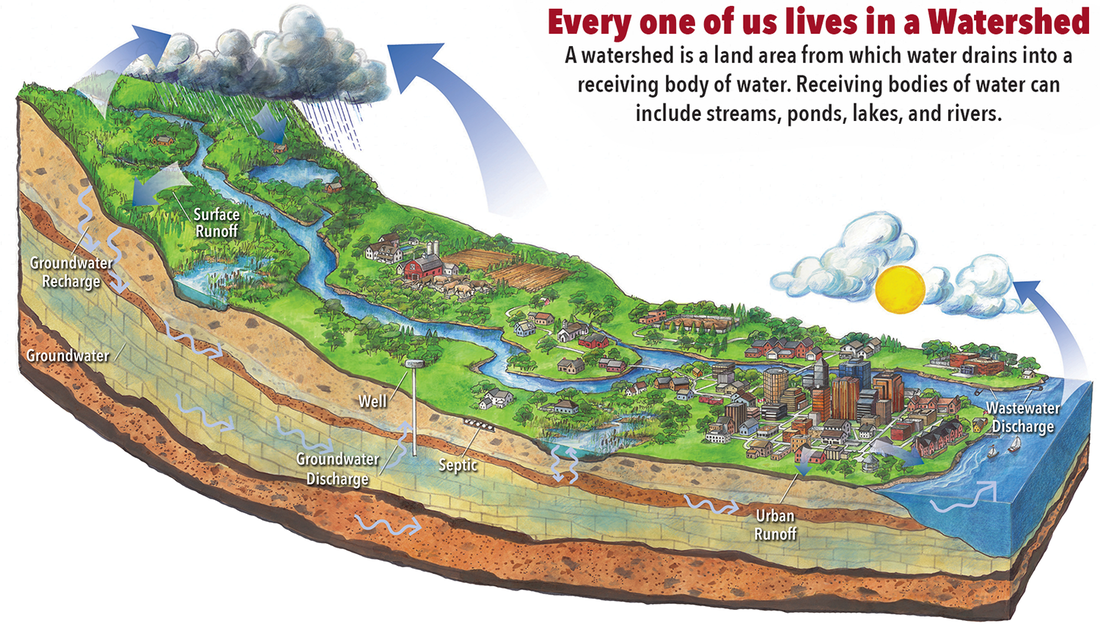Watersheds
What is a Watershed?
A watershed is the area of the land's surface that drains to a particular water body. Boundaries are generally based on high elevations. For instance, the continental divide is North America's most famous watershed boundary. On the east side of the continental divide, the rivers and other water bodies all drain to the Atlantic Ocean. On the west side of the continental divide, all of the waters drain to the Pacific Ocean.
|
Learn more about a specific watershed
|
What is a Watershed Management Plan?
A watershed management plan identifies problems and threats to water resources and develops a framework to address these issues within a specific watershed. It is useful as both a process and a tool. The process alone is valuable.
A watershed management plan identifies problems and threats to water resources and develops a framework to address these issues within a specific watershed. It is useful as both a process and a tool. The process alone is valuable.
The Watershed Council has been a key party involved with the development of watershed management plans for all major watersheds as well as several sub-watersheds in our service area. Most of these plans are now available for viewing or download.
To get involved in the Watershed Management Plan development process, join a Watershed Advisory Committee near you.
Watershed Size
Watersheds may be characterized by their size. Large watersheds may encompass thousands of square miles; small watersheds may include only several square miles. The Lake Michigan Watershed, a large watershed, includes 45,598 square miles. This gives a watershed-to-water surface area ratio of about 2:1, which is relatively low. Lake Michigan's water originates from precipitation falling throughout its watershed.
Watersheds may be characterized by their size. Large watersheds may encompass thousands of square miles; small watersheds may include only several square miles. The Lake Michigan Watershed, a large watershed, includes 45,598 square miles. This gives a watershed-to-water surface area ratio of about 2:1, which is relatively low. Lake Michigan's water originates from precipitation falling throughout its watershed.
Watershed Features
The features of a watershed influence the characteristics of its receiving water body. These features include things like:
The features of a watershed influence the characteristics of its receiving water body. These features include things like:
- Soils
- Vegetation
- Climate
- Topography
- Geology
- Human Land Use
Because each watershed has different conditions, each lake and stream is unique. For instance, because of the limestone which is prevalent throughout much of the Lake Michigan basin, the water has high levels of calcium and magnesium (termed hardness), and carbonates (which create alkaline conditions), and as such, is well buffered against acid precipitation.
Water Quality and Pollution
The water quality of a lake is a reflection of the activities surrounding it within its watershed. There are two major types of pollution: point source and nonpoint source.
Point source pollution comes from an easily identifiable source, such as a discharge pipe from a factory.
Nonpoint source pollution is pollution which comes from more diverse and diffuse sources that are not usually so obvious. Examples include soils that are eroded as a result of human activities, or substances which have been applied to land, such as fertilizers. Nonpoint source pollution reaches surface water primarily through runoff from rainfall or melting snow that picks up contaminants from the land. It can also include subsurface drainage such as leachate from septic systems, and airborne pollutants such as emissions from cars and power plants that produce acid rain.
The water quality of a lake is a reflection of the activities surrounding it within its watershed. There are two major types of pollution: point source and nonpoint source.
Point source pollution comes from an easily identifiable source, such as a discharge pipe from a factory.
Nonpoint source pollution is pollution which comes from more diverse and diffuse sources that are not usually so obvious. Examples include soils that are eroded as a result of human activities, or substances which have been applied to land, such as fertilizers. Nonpoint source pollution reaches surface water primarily through runoff from rainfall or melting snow that picks up contaminants from the land. It can also include subsurface drainage such as leachate from septic systems, and airborne pollutants such as emissions from cars and power plants that produce acid rain.




